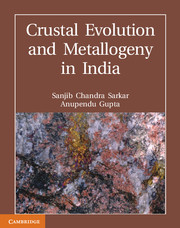Book contents
- Frontmatter
- Dedication
- Contents
- List of Figures
- List of Tables
- List of Plates
- Preface
- Chapter 1 Southern India
- Chapter 2 Central India
- Chapter 3 Eastern Ghat Belt
- Chapter 4 Eastern India
- Chapter 5 North-East India
- Chapter 6 Western India
- Chapter 7 The Himalaya
- Chapter 8 Crustal Evolution and Metallogeny in India: A Brief Review in the Context of the World Scenario
- References
- Index
- Plate Section
Chapter 2 - Central India
Published online by Cambridge University Press: 05 February 2014
- Frontmatter
- Dedication
- Contents
- List of Figures
- List of Tables
- List of Plates
- Preface
- Chapter 1 Southern India
- Chapter 2 Central India
- Chapter 3 Eastern Ghat Belt
- Chapter 4 Eastern India
- Chapter 5 North-East India
- Chapter 6 Western India
- Chapter 7 The Himalaya
- Chapter 8 Crustal Evolution and Metallogeny in India: A Brief Review in the Context of the World Scenario
- References
- Index
- Plate Section
Summary
Geology and Crustal Evolution
Introduction
The central segment of the Indian Precambrian Shield comprises two distinct crustal provinces, viz, the Northern (Bundelkhand) Crustal Province and the Southern (Bastar) Crustal Province (Fig. 2.1.1). The Northern Crustal Province again is bifurcated into, the Bundelkhand cratonic area and the ENE–WSW trending wide zone of accretion to its south, known as the Central Indian Tectonic Zone (CITZ).
The Bastar Crustal Province is characterised by an Archean cratonic nucleus represented by widely dispersed older supracrustals (the Sukma Group and its equivalents), regionally deformed and metamorphosed with a TTG crust (> 3.0 Ga) and the younger (Neo–Archean to Meso–Proterozoic) supracrustals occurring as well denned N–S trending volcanisedimentary belts. Younger granitic bodies invaded both the older and younger supracrustals. Till date, the oldest in situ rock-age (3.58 Ga) from India has been obtained from the Bastar craton, surprisingly from a typical granite.
A semicircular granite–gneiss massif represents the Archean cratonic nucleus of the Bundelkhand Crustal Province (> 3.0 Ga) with numerous older supracrustal enclaves. The southern and southeastern boundary of Bundelkhand massif is overlain by Paleo– to Meso–Proterozoic Bijawar Group, dominantly composed of metasediments and associated volcanics. There is another metasedimentary package overlying the Bundelkhand massif in its northern part known as the Gwalior Group, which is considered time-equivalent of the Bijawars. Indo–Gangetic alluvial cover marks the northern limit of Bundelkhand massif.
- Type
- Chapter
- Information
- Crustal Evolution and Metallogeny in India , pp. 153 - 318Publisher: Cambridge University PressPrint publication year: 2012



